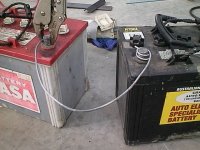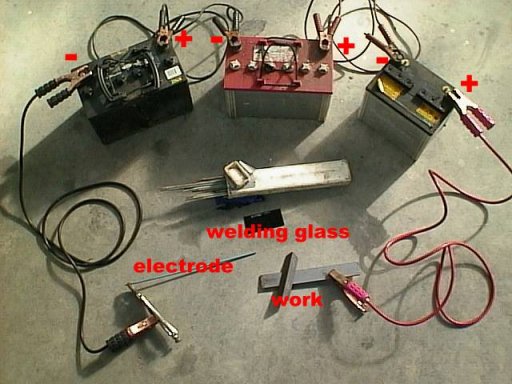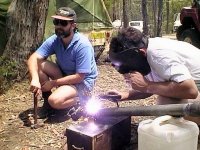Techniek - Lassen met accu's
![]()
Thom vond een interessant artikeltje op het internet waarin beschreven werd hoe je met drie in serie geschakelde auto-accu's van 12Volt, simpel maar doeltreffend kunt lassen. Mocht je zoiets willen gaan proberen; wij nemen geen enkele verantwoordelijkheid voor eventuele gevolgen! ;-)
General information:

Simpele auto-accu's... Most DC welders work at around 40 volts, and a general purpose electrode of 3.25mm will need about 120 amps for good penetration of weld. 36 volts is available from three automotive batteries connected in series. The batteries we use in 4WDs are more than capable of supplying the amperage for an ample amount of time for a repair weld; after all, they supply winches at up to 400 amps, and starters on diesels at 300 plus! There is no danger of electrical shock using automotive batteries in this manner; however, the batteries should be disconnected from the vehicle, and protected from welding sparks.
Case histories:
In the late seventies, three other Land Cruisers and mine traversed the Canning Stock Route in Western Australia. In those days the route was ill defined and there was no support in the way of fuel dumps, and water supplies were unreliable. We carried heavy loads of fuel and water (650 litres fuel and 60 litres water each) and supplies for 20 days. The weight and rough conditions caused one vehicle to break a front wheel bearing spindle. We painstakingly filed the fracture to a vee for welding, welded it, filed it to refit the bearings, and it lasted 100 metres before breaking again. We then hack sawed off a piece from the inner axle and welded it through the spindle to make a solid unit. The vehicle no longer had 4WD, and required towing over some dunes, but it made it home
In the early eighties I built six land yachts, and with some friends, circumnavigated Lake Frome (large dry salt lake in South Australia). One of our group was nicknamed "Disaster Dave". In thousands of square kilometres of lake, Dave was quite capable of having a head on with one of the other yachts; and he did, breaking his yacht's chassis in half. We were able to use battery welding to get him mobile again.
On two separate occasions while doing some cross country exploration in the Simpson Desert, we successfully welded broken main leaves in a Hilux and MQ Nissan. This was done with general purpose rods by filing the breaks to a vee, warming the spring in a fire to weld, and burying welded area in warm sand to slowly cool and stress relieve the weld
The photo of Bal and Richard (bottom picture) shows them constructing a makeshift drive shaft from a piece of water pipe. This became necessary when the shaft banged on a rock and was twisted completely in two pieces.

De benodigdheden voor elektrisch lassen met auto-accu's This is all you need for battery welding. The light jumper leads joining the batteries are carried in my tool kit specifically for this purpose. The various size general purpose electrodes and glass from a welding mask are carried in the plastic electrode box, and held against movement by a rag stuffed in the box with them. The electrode is more easily held by a pair of vice grips than it is by the jumper lead clamps. You will notice that the earth to the work is positive. This is the norm in DC welding. One would normally keep the work as far as possible from the batteries, and cover the batteries with a ground sheet or blanket. This reduces the possibility of sparks from the weld igniting the hydrogen gas produced by the batteries. Batteries do not need to be all the same size. If three batteries are not available, 24 volts can be used, but it will be difficult to hold an arc unless you are an very experienced welder. With 12 volts only, an acceptable weld is virtually impossible. This shows one method of introducing resistance to the circuit to reduce amperage for small diameter electrodes. It is simply a piece of "good ole" No 8 fencing wire. It can be increased/decreased in length to change resistance, and held to battery post by vice grips or tight twisting.

Gebruik een lasbril! Be aware that this piece of wire will get very hot; perhaps to the point where it will droop and melt the plastic battery case(s). KEEP AN EYE ON IT! Heavier wire, or smaller wire doubled up, can be used to join all the batteries if no jumper leads are available In this case Bal was able to scrounge a welding mask. If no mask is available, tape your welding glass into a cut-out in a piece of cardboard. A mask and skin covering is necessary to prevent radiation burn (like sunburn) only if you are doing any appreciable amount of welding. If the weld is going to be short (a few seconds only) simply hold the glass close to your eyes. In high ambient light (bright sunlight) you will get away with using a couple of pairs of sun glasses on top of each other. DO NOT attempt to weld without proper welding glass in low ambient light conditions. In these conditions, heavily dilated eye pupils will allow intense welding light to damage eye retina.
Bron: Safari 4x4
Auteur: Norm[ vorige pagina ]
![]()